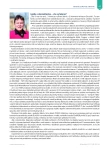The study ODYSSEY CHOICE I with alirocumab: more data on PCSK9 inhibition
Authors:
Michal Vrablík; Eva Tůmová
Authors‘ workplace:
Centrum preventivní kardiologie III. interní kliniky 1. LF UK a VFN v Praze
Published in:
AtheroRev 2017; 2(2): 107-113
Category:
clinical studies
Overview
The search for an optimum method of inhibiting proprotein convertase subtilisin kexin (PCSK9) goes on and the clinical researches into monoclonal antibodies to PCSK9 (PCSK9-inhibitors) continue to yield new information. Recently the results of the study ODYSSEY CHOICE I have been published, which tested efficiency and safety of alirocumab administered in the dose of 300 mg once a month, compared to placebo and a group of patients treated with alirocumab in the dose of 75 mg once in 14 days. The study lasted 48 weeks. 803 patients were divided based on statin doses into the study’s therapeutical branches (alirocumab 300 mg 1× a month, placebo, alirocumab 150 mg 2× a month) in the ratio of 3 : 2 : 1. Average lowering of LDL-C levels in the 24th week of the study with alirocumab doses of 300 mg administered 1× a month was -52.7 % in the patients not treated with statins (placebo -0.3 %), and -58,8 % in the users of statins (placebo -0.1 %). 14.7 % participants not using statin and 19.3 % statin users on the study had their dose changed in the 12th week from 300 mg alirocumab 1× a month to 150 mg administered 1× in 2 weeks due to insufficiently balanced therapeutic response. Incidence of adverse effects was similar among the users of active therapy and those taking placebo (61.1–75 % in the placebo branch, 71.5–78.1 % in the alirocumab branch). Relatively higher efficiency of PCSK9 inhibition was demonstrated again in statin users, who have increased PCSK9 concentrations as the accompanying effect of their LDL-C lowering effect. Very good efficiency of alirocumab and its safety profile have been proven again. A dose taken once in a month may bring an improvement in adherence and thereby also in long-term therapeutical results, although at the moment the data to test this hypothesis is not available. The possibility of using a long dosing interval will contribute to further individualization of therapy and it represents a suitable extension of the dosing spectrum of alirocumab.
Key words:
alirocumab, LDL-cholesterol, ODYSSEY CHOICE I, PCSK9 inhibition
Sources
1. Kereiakes DJ, Robinson JG, Cannon CP et al. Efficacy and safety of the proprotein convertase subtilisin/kexin type 9 inhibitor alirocumab among high cardiovascular risk patients on maximally tolerated statin therapy: The ODYSSEY COMBO I study. Am Heart J 2015; 169(6): 906–915. e13. Dostupné z DOI: <http://dx.doi.org/10.1016/j.ahj.2015.03.004>.
2. Roth EM, Taskinen MR, Ginsberg HN et al. Monotherapy with the PCSK9 inhibitor alirocumab versus ezetimibe in patients with hypercholesterolemia: results of a 24 week, double-blind, randomized Phase 3 trial. Int J Cardiol 2014; 176(1): 55–61. Dostupné z DOI: <http://dx.doi.org/10.1016/j.ijcard.2014.06.049>.
3. Bays H, Gaudet D, Weiss RA et al. Alirocumab as Add-On to Atorvastatin Versus Other Lipid Treatment Strategies: ODYSSEY OPTIONS I Randomized Trial. J Clin Endocrinol Metab 2015; 100(8): 3140–3148. Dostupné z DOI: <http://dx.doi.org/10.1210/jc.2015–1520>.
4. Robinson JG, Farnier M, Krempf M et al. [ODYSSEY LONG TERM Investigators]. Efficacy and safety of alirocumab in reducing lipids and cardiovascular events. N Engl J Med 2015; 372(16): 1489–1499. Dostupné z DOI: <http://dx.doi.org/10.1056/NEJMoa1501031>.
5. Rey J, Poitiers F, Paehler T et al. Randomized, partial blind study of the pharmacodynamics, pharmacokinetics and safety of multiple subcutaneous doses of alirocumab, a fully human monoclonal antibody to proprotein convertase subtilisin/kexin type 9, administered every 4 weeks alone or in combination with ezetimibe or fenofibrate in healthy subjects. Poster presentation at the American College of Cardiology Scientific Sessions 2014. Abstract 1183–131. J Am Coll Cardiol 2014; 3(12 Supplement): A1375.
6. Seidah NG, Awan Z, Chrétien M et al. PCSK9: a key modulator of cardiovascular health. Circ Res 2014; 114(6): 1022–1036. Dostupné z DOI: <http://dx.doi.org/10.1161/CIRCRESAHA.114.301621>.
7. Stein EA, Gipe D, Bergeron J et al. Effect of a monoclonal antibody to PCSK9, REGN727/SAR236553, to reduce low-density lipoprotein cholesterol in patients with heterozygous familial hypercholesterolaemia on stable statin dose with or without ezetimibe therapy: a phase 2 randomised controlled trial. Lancet 2012; 380(9836): 29–36. Dostupné z DOI: <http://dx.doi.org/10.1016/S0140–6736(12)60771–5>.
8. Roth EM, Moriarty PM, Bergeron J et al. A phase III randomized trial evaluating alirocumab 300 mg every 4 weeks as monotherapy or add-on to statin: ODYSSEY CHOICE I. Atherosclerosis 2016; 254: 254–262. Dostupné z DOI: <http://dx.doi.org/10.1016/j.atherosclerosis.2016.08.043>.
9. Catapano AL, Graham I, De Backer G et al. ESC/EAS 2016 guidelines for the management of dyslipidemias. Eur Heart J 2016; 37(39): 2999–3058. Dostupné z DOI: <http://dx.doi.org/10.1093/eurheartj/ehw272>.
10. Sabatine MS, Giugliano RP, Keech AC et al. [FOURIER Steering Committee and Investigators]. Evolocumab and Clinical Outcomes in Patients with Cardiovascular Disease. N Engl J Med 2017; 376(18): 1713–1722. Dostupné z DOI: <http://dx.doi.org/10.1056/NEJMoa1615664>.
11. Ridker PM, Mora S, Rose L. [JUPITER Trial Study Group]. Percent reduction in LDL cholesterol following high-intensity statin therapy: potential implications for guidelines and for the prescription of emerging lipid-lowering agents. Eur Heart J 2016; 37(17):v1373–1379. Dostupné z DOI: <http://dx.doi.org/10.1093/eurheartj/ehw046>.
Labels
Angiology Diabetology Internal medicine Cardiology General practitioner for adultsArticle was published in
Athero Review

2017 Issue 2
Most read in this issue
- What is the role of nutriceuticals in dyslipidemia management? Armolipid Plus
- Combination treatment with antihypertensive and hypolipidemic drugs
-
Remnant cholesterol: a fact or fiction?
Reflection on the problems related to remnant cholesterol - Changes in the lipid spectrum in endocrinopathies
